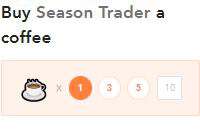Market Radar 22. December 2022
Market
The chemistry is no longer right
Stock market participants bought massive put options yesterday
Yesterday at 7 p.m. German time, the trading volume for put options on equities (including ETFs) rose rapidly at the CBOE. Obviously, many traders have chosen to hedge with put options during a rising stock market. Since a relatively large number of private investors currently operate on the market during regular trading hours compared to institutional investors, they obviously expect share prices to fall.
Sentiment follows the pattern: sell when others sell.
The sentiment measured by the American Association of Individual Investors (aaii), which is published once a week, confirms this market opinion for retail investors. Currently, 52.3% of respondents feel in the bear camp and 20.3% in the bull camp. 27.4% stated that they were neutral, i.e. probably wait-and-see.
Such surveys via surveys are regarded as a counter-indicator: If share prices rise, then more private investors switch to the bull camp. If share prices fall, more private investors switch to the bear camp. This pattern can still be observed from week to week. Recently, prices have fallen, so the number of those who expect prices to fall is increasing. This year, however, it has become more difficult to determine low points in the market via the sentiment survey. One example is the survey of 21 September, against which absolute extreme values were measured. At the time, 17.7% said they were bullish and 60.9% said they wanted to position themselves bearishly. However, the currently still valid striking low in the S&P 500 was only reached on 13 October, i.e. about three weeks after this extreme positioning.
Get the Seasonal Tradingsignals on you cell phone
When will the sell-off in the major stock indices come?
For today, the S&P 500 (SPY) and Russell 2000 (IWM) are downgraded. As of today, both stock indices will receive the daily stamp “Wait and see or speculate on sell-off”. The Nasdaq 100 (QQQ) has been receiving this day stamp since December 19.
However, the equally weighted models for the S&P 500 (RSP) and the Nasdaq 100 (QQQE) still receive the daily stamp “Buy the Dip”. So it doesn’t look so bad if highly weighted stocks like Alphabet, Amazon or Apple are weighted in the index in the same way as less highly capitalized stocks.
We receive entry stamps for the short side for today for the Russell 2000 and for Latin America (ILF).
What do we see under the radar of major US stock indices?
Four industries receive an entry recommendation on the short side for today, i.e. traders could now short-sell stocks in an overbought position – i.e. enter into a swing trade on the short side: regional banks (KRE), consumer cyclical stocks (XLY), uranium (URA) and biotechnology (XBI).
Within the biotechnology industry, however, many stocks lead a life of their own and correlate little with the peer group. In addition, the short selling of biotechnology stocks is associated with such high risks that I would generally advise against it.
Uranium Energy with lower loss than expected
Uranium Energy (UEC) reported quarterly figures from the uranium sector on Monday after the stock exchange. The loss was smaller than expected by market participants. As a result, the stock rose sharply for two days in a row and closed yesterday at $3.69, higher than the interim high reached on December 13 ($3.66). Therefore, I would not necessarily want to sell this stock short.
Chemistry yesterday with little pressure upwards
In terms of chart technology, I currently notice stocks from the chemical sector for short sales. The ETF with the symbol XLB invests in materials and basic materials and contains a relatively large number of stocks from the chemical sector. There we recently saw more days on which the ETF fell over the course of the day with high trading volumes.
Yesterday’s recovery in US chemical giant DuPont de Nemours (DD) looked pretty puny compared to other stocks. On the chart, the stock left a constructive-looking flat base on September 15 and could not “muster the strength” to return to the base level yesterday. An extension of the consolidation now seems more likely to me than a start of the interim high reached on December 13 ($ 71.85). Dupont Denemours shares closed at $68.32 yesterday. The consolidation could extend to $65, maybe $60.
We see a similar chart picture at the US competitor Dow (DOW).
Alternativ böte sich der deutsche Chemieriese BASF (WKN: BASF11) an. Die Aktie notiert am oberen Ende des Trendkanals bei aktuell ca. 46,50 EUR und dürfte nun wieder Richtung untere Begrenzung fallen. Allerdings befindet sich bei 45 EUR eine horizontale Unterstützung, die kurzfristig Halt bieten könnte. Sollte diese gerissen werden, könnte es in der BASF Aktie relativ schnell Richtung 40 EUR runter gehen – dann vermutlich zeitgleich mit einem Ausverkauf im deutschen Leitindex DAX.

